together with Alexander Richter und Michael Kammertöns
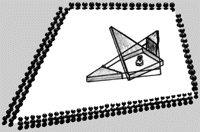
The Aims
Our memorial is on the one hand a place of sadness and reflection about the 6 million murdered European Jews,
on the other hand it's an attempt to transcend dismay and sadness with a positive approach towards the present
and the future.
Our Memorial attempts
* to further reflection on the dimension of the crime,
* to support the debate on this crime,
* to offer a possibility of transcending sadness and dismay,
* to convey the continuity of Jewish life in Europe,
* to further the pursuit of studies on the negative results of nationalistic thinking,
* to strengthen the will to in future resist anti Semitism,
* to offer a possibility of a direct exchange between descendants of the victims and the perpetrators about their experience of, their reflection on and their coming to terms with the memorial,
* to bring the descendants of the victims and perpetrators closer together through understanding,
* to try to overcome that which separates the descendants of the victims and perpetrators.
The Means
A Warped Star of David: The outer shape of the memorial is a warped Star of David, formed by two triangles.
The lower triangle mirrors the development and implementation of the annihilation of Jewish life by the National Socialists.
The brutal intrusion of National Socialism into Jewish life in Europe and the subsequent annihilation of 6 million Jews is reflected in the wedge of the two triangles. The forceful penetration of the Triangle of Death into the Triangle of Jewish Life bent the Triangle of Jewish Life and completely warped the Star of David.
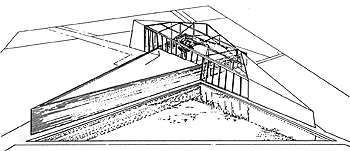
The difference between the two triangles is emphasised:
* through the different construction materials used. Old bricks for the lower, concrete and glass for the higher triangle,
* by the fact that the Triangle of Jewish Life towers above the Triangle of Destruction, and thus underlines the continuation of Jewish life in Europe in spite of the National Socialist genocide,
* by the glass construction in the centre of the Triangle of Jewish Life, which from above shows both the past -the Triangle of Destruction- as well as the future symbolised by an olive tree,
* by the constant height of the Triangle of Destruction compared to the rising height of the Triangle of Jewish Life,
* by the lack of windows in the Triangle of Destruction and
* by the fact that at night the Triangle of Jewish Life through the inner illumination and the glass walls strongly protrudes over the (dark) Triangle of Destruction.
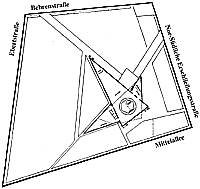
The corners of the memoriale point to places of present day Jewish life in Berlin as well as to places and buildings relating to the National Socialist policy of genocide.
The Direction of the Triangle of Destruction
1. The Northern Corner points to the Brandenburg Gate where on the night of January 30th, 1933 the National Socialists held a rally to celebrate Hitler's nomination as Chancellor.
2. The Eastern Corner points to the Opera House Square where on the night of May 10th, 1933 the National Socialists set lite to thousands of books.
(Heinrich Heine wrote: "That was but a prelude. Where one burns books, one finitely also burns human beings").
3. The Southern Corner points to both the former site of Hitler's Chancellery on Voßstraße, to the former headquarters of the SS, SA and Gestapo on Niederkirchener Straße and to the Villa on Lake Wannsee, where on January 20th, 1942 a conference was held to implement the genocide of Europe's Jews.
The Corners of the Triangle of Destruction:
Three dates 30.1.1933, 10.5.1933 and 20.1.1942 are to
be cast in large numerals outside the memorial building
on the appropriate corners of the Triangle of Destruction.
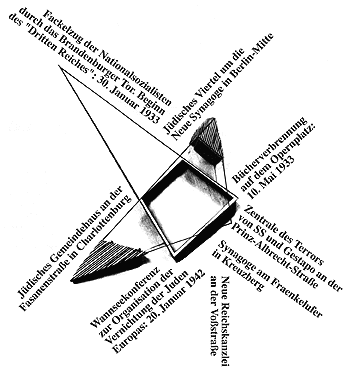
The Direction of the Triangle of Jewish Life
1. The North Eastern Corner points to the Oranienburgerstraße, an area of former and present day Jewish life in downtown Berlin.
2. The South Eastern Corner points to the synagogue on Fraenkelufer in Kreuzberg.
3. The South Western Corner points to the Jewish Community Centre in Fasanenstraße in Charlottenburg.
1. When visiting a cemetery Jews bring stones to place on the graves of their friends or relatives. The stones are placed on the grave to say: "Someone was here and thought of you."
2. By Jewish tradition at least a stone should remember a dead person should he or she not have a grave.
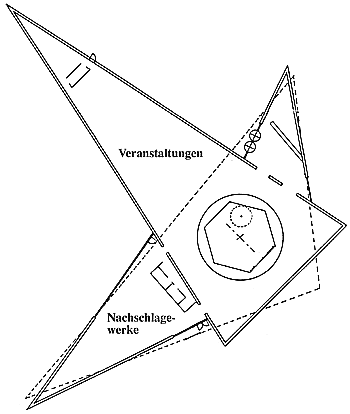
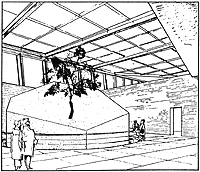
The tree itself acts as the transition from the past towards the present and the future. It makes clear:
1. that the attempt to annihilate Jewish life in Europe did not -and will not- ever succeed, and
2. that Jewish life in Europe has a present and a future
"They were part of us -
They are part of us."
It has a double meaning which is intended to incite the visitor to remember and to reflect. At the same time the sentence has a different context for a Jewish and a non-Jewish visitor.
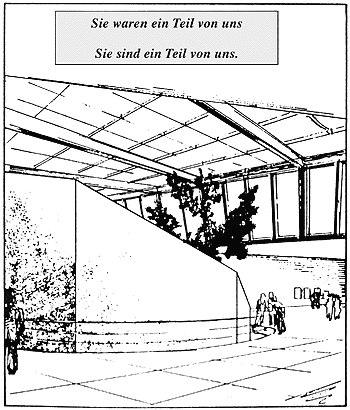
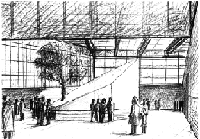
At the lower end of the Triangle of Jewish Life is a room which offers the visitor the possibility of searching -with the aid of computers and documents- for a specific victim, thus helping to individualise the figure of 6 million dead. The two walls will carry maps showing the Jewish communities in Europe before 1933 and since 1945. The latter map will be a continual 'work in progress'.